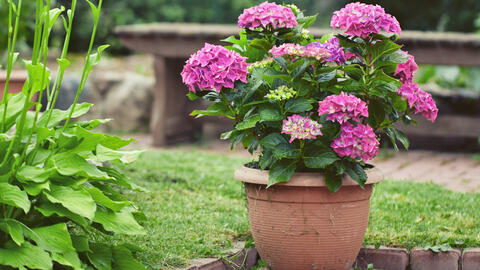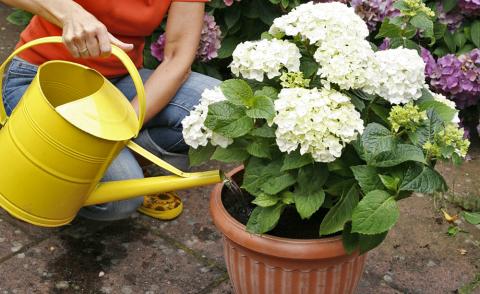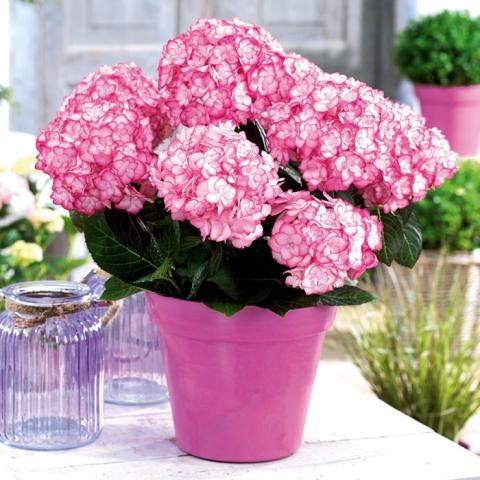Potted Hydrangeas: Planting and Care Tips
Be it in pots or flower beds: Hydrangeas look dignified and wonderfully old-fashioned. It’s no coincidence that they are typical cottage garden plants. They make a brilliant comeback every now and again: With the boom in cottage gardens, the magnificent bloomers have once again taken hearts by storm.

Luxuriant Hydrangea flowers match well with pots with a clay look
Whether it’s a small plant for the windowsill, a container plant or a garden shrub, they’re all cultivars of Hydrangea macrophylla. There are two types: those with ball-shaped umbels and Mountain Hydrangeas, also known as lacecap.

There are a few things to remember when caring for the flowering shrubs: Hydrangeas tolerate low levels of lime. You should therefore use Rhododendron or Azalea soil and only use softened water. Hard tap water causes yellow, chlorotic leaves after a while. To ensure that Hydrangeas develop well, feed them a special Hydrangea fertilizer every two weeks between March and August. It is lime-free and formulated to meet their specific requirements. Hydrangeas flower at the terminal buds and therefore do not need cutting. You simply cut off the brown umbels and remove dry wood in spring. If you completely cut back a Hydrangea, it will not initially flower.
A lot of moisture evaporates from the large green leaves, they therefore need plenty of water. The substrate should always be moist, but there should be no waterlogging. Potted plants that have gone limp should be immersed in water for a few minutes and drained off. The soil in the Hydrangea pot should never dry out. The right location also protects against this: it should be semi-shaded to shaded, and sheltered from the wind. Put Hydrangeas outdoors close to the house, at the entrance or on a balcony or patio. These are the best places to enjoy their flowers. They look particularly good combined with stone and furniture.
Hydrangeas in pots or tubs should not be placed in the direct midday sun, as the plants can burn in strong sunlight. Potted Hydrangeas also like a bright spot indoors. They need to be protected from direct midday sun in the house too. Tip: if you move the pots to a cooler spot at night, such as a staircase or bedroom, the flowers will last particularly long.

As the plants lose their leaves in winter, a dark cellar is a good place for overwintering. Temperatures of 41 degrees Fahrenheit are ideal. The soil should not be allowed to completely dry out. You should give it a little water from time to time! When the first leaf buds appear, the plant needs light. However, the young buds need to be protected from late frosts outdoors. Overwintering can cause potted Hydrangeas to bloom early. Once a rhythm has been established, the plants will bloom later during their natural flowering period. They will reach their peak in June at the earliest.

“Why are my Hydrangea’s blue flowers turning pink?” Questions like this are often sent in by readers. The trick: the roots absorb aluminum from the soil to produce the blue color. This only happens if it’s acidic. Therefore: Place Hydrangeas in soil for bog garden plants (azalea soil), water with softened water and add aluminum: 0.5 to 1 tsp potassium alum or ammonium alum (available at pharmacies) per liter of water every time you water them. An even easier option is to use a special fertilizer for blue Hydrangeas.
Hydrangeas that have become too big for containers can be planted in the garden. Spring is a good time for this, as the plants have until fall to successfully establish roots. Choose a north or west facing location in light shade. The risk of late frosts is too great in east facing locations, this can damage flower buds and shoots. Hydrangeas need loose, humus-rich soil. Limey soils are not suitable. Dig a hole that is twice the size of the root ball. Loosen the soil. You can mix the dug soil with Rhododendron soil. Plant the root ball as deep as before and water it well.

Unfortunately, as nice as they are to look at, hydrangeas are relatively susceptible to various plant pests and fungi. You should therefore check indoor Hydrangeas for spider mites on a regular basis. They multiply particularly well during the winter months. Outdoors, aphids are the most common unwanted guests for Hydrangeas, particularly when new growth starts to emerge. Moreover, Hydrangeas are often affected by gray mold, powdery mildew, fungi, and various leaf spot diseases.

